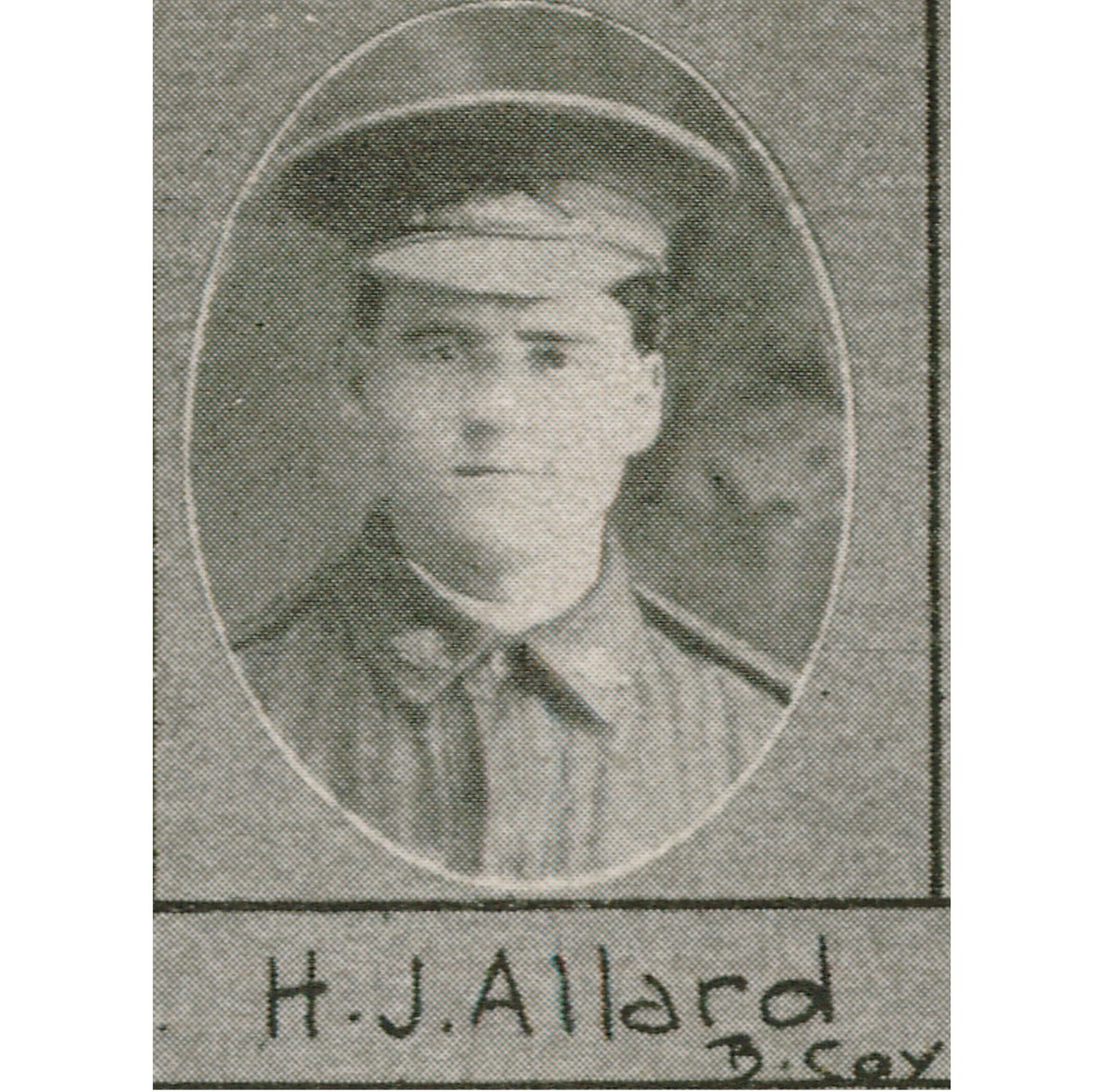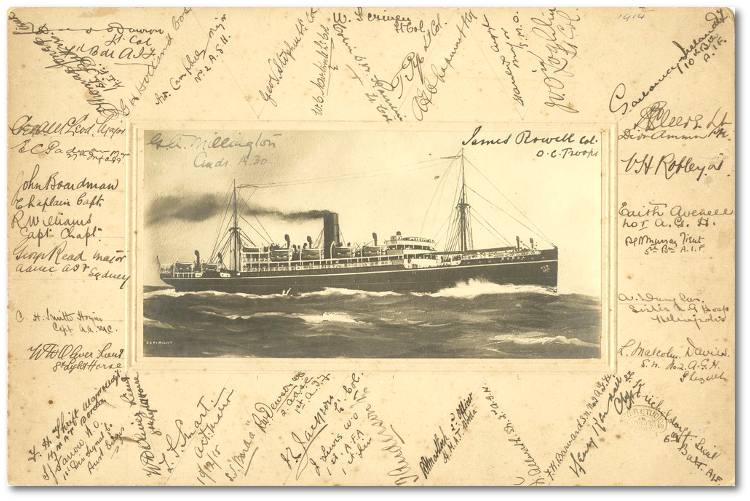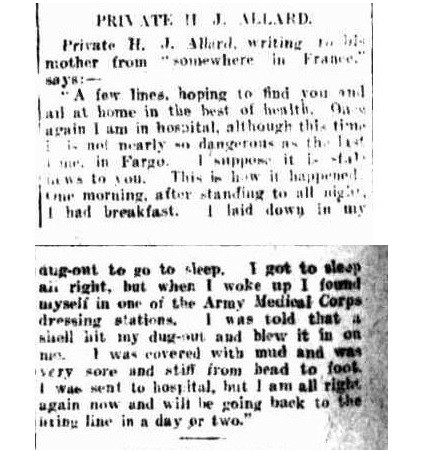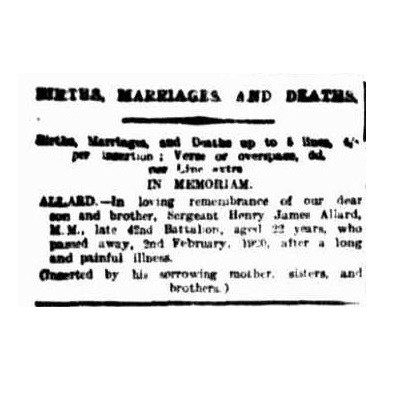Henry James Allard 42nd Infantry Battalion: Trench Nephritis
By Alice Rawkins, Visitor Service Assistant, Anzac Square Memorial Galleries. | 12 April 2021
The nature of trench warfare in the First World War forced hundreds of thousands of men to live in close proximity, resulting in the spread of viral, parasitic, and bacterial infections. Unhygienic living conditions, poor diet, stress, lack of sleep, exposure to the elements and contact with vermin and parasites created the perfect environment for illness and disease to flourish. Those who survived the war often experienced long lasting medical issues or died years later from health issues acquired while serving. For many soldiers, their suffering continued long after the Armistice was signed in 1918. This was the case for Queensland soldier Henry James Allard, who was discharged from the Australian Imperial Forces (AIF) after developing Trench Nephritis, an illness that would eventually claim his life.

H.J. Allard B. Coy, one of the soldiers photographed in The Queenslander Pictorial, supplement to The Queenslander, 1916, State Library of Queensland, Image number: 702692-160715-s0024-0001.
Henry James Allard, service no. 255, enlisted in the AIF on the 4 October 1915 and was assigned to the 42nd Infantry Battalion, B Company. The Rockhampton local was the son of Catherine and Herbert Allard and one of ten siblings. At the time of his enlistment, he was 18 years and 9 months old and working as a grocer. Following training he embarked overseas from Sydney aboard the HMAT A30 Borda on 5 June 1916. His unit arrived in Southhampton on 23 July 1916 where they undertook additional training at Larkhill and Wareham.

Photograph of HMAT ship 'Borda' 1915. State Library Queensland, John Oxley Library, Image number 30037.
In September 1916 Allard was hospitalized with Influenza, which developed into a serious case of pneumonia. It took him several months to recover, including a period of convalescence before he re-joined his unit on 18 November 1916. James proceeded overseas to France aboard the S.S Golden Eagle on 28 February 1917. The 42nd battalion had taken up a frontline position during the winter of 1916-17. During this period, they also undertook further training and laboring tasks in the rear areas when not at the line.
On the 11 April 1917 Allard was wounded when a shell hit his dug out. He was transferred to 2nd Australian Casualty Clearing Station and treated for a hematoma on his head. He wrote to his mother recounting the event and assuring her of his health. The letter was then published in the Morning Bulletin on 3 July 1917. In a blasé fashion he explained:
“Once again I am in Hospital, although this time is not nearly so dangerous as the last time, in Fargo. I suppose it is stale news to you. This is how it happened. One morning, after standing to all night, I had breakfast. I laid down in my dug-out to go to sleep. I got to sleep all right, but when I woke up I found myself in one of the Army Medical Corps Dressing stations. I was told that a shell hit my dug out and blew it in on me. I was covered in mud and was very sore and stiff from head to foot. I was sent to hospital, but I am all right again now and will be going back to the firing line in a day or two.”
Allard rejoined his battalion on the 17 April 1917. This event highlights the dangers of serving, which was not restricted to battles, but could persist while in camp.

Private H.J Allard. In Morning Bulletin (Rockhampton, Qld. : 1878 - 1954), Tuesday 3 July 1917, page 7, Trove.
During his service Allard slowly worked his way up through the ranks, promoted to Lance Corporal in July 1917, Vice Corporal in August 1917, and Sergeant in September 1917. He was also awarded the Military Medal for his actions during the Battles of Messines. His service records reveal that;
“On the 31st July in the assault East of Messines this man displayed great initiation and cool courage on his platoon commander becoming a casualty. He took charge of his platoon, reorganised it under heavy machine gun fire. After the assault he successfully withdrew his men and started them on their allotted tasks of digging communication trenches. His coolness and energy afforded an excellent example to the men and contributed greatly to our success in this sector.”
His achievements were published in the London Gazette on 25 September 1917 and the Australian Gazette on 24 January 1918.
In April 1918, Allard was admitted to hospital with Trench Fever, a bacterial disease transmitted by lice. The symptoms of this illness include fever, muscle aches, pains behind the eyes, serve headaches, joint pain, rashes, liver and spleen enlargement and pain in the shins. He was invalided back to England for treatment at a Military Hospital at Magdalene Camp, Winchester. However, by June he had developed Trench Nephritis, an infection of the kidneys. This illness affected his kidney’s ability to filter waste from the blood system. Other symptoms included high blood pressure, swelling of the legs and face, headaches, sore throat, difficulty breathing and bronchitis. The mortality rate for this illness was low, however, recovery was often lengthy and painful. Due to the seriousness of Allard’s condition, he was invalided back to Australia in July 1918.
Sadly, Allard developed chronic Nephritis, which caused his kidneys to fail. He died at 7pm on 2 February 1920 at the 17th Australian General Hospital, Enoggera. Unlike many soldiers who died during WWI he was not alone at the time of his passing rather his mother, Catherine, was at his side. A military funeral was held at Toowong Cemetry at 4pm on 3 February. In a notice placed in the Morning Bulletin his family described his illness as “long and painful.”

Death notice - Allard, Morning Bulletin, 2 February 1922, pg. 1. Trove,
Henry James Allard’s name is recorded on the honour roll for the 42nd Infantry Battalion that resides in the World War One Crypt at Anzac Square. Despite dying two years after the conclusion of WWI his name is included as his death was a consequence of this conflict. As we approach Anzac Day 2021 let us take a moment to remember those who suffered from illness and diseases contracted while serving to protect the interest of Australia and the British Empire. This is a topic that is sometimes forgotten when considering Australian’s Military history, but it was lived reality for thousands of Australian troops and their families. These are the unpleasant realities of war that must be remembered.
Learn more about the 42nd Infantry Battalion and those who served in this unit by visiting the Anzac Square Memorial Galleries, open Sunday-Friday, 10am-4 pm . Alternatively enjoy our online content from the comfort of your home via our website.
Comments
Your email address will not be published.
We welcome relevant, respectful comments.